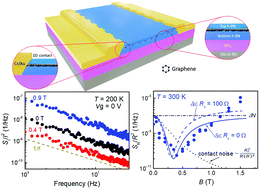Nature of the 1/f noise in graphene—direct evidence for the mobility fluctuation mechanism†
Abstract
The nature of the low-frequency 1/f noise in electronic materials and devices is one of the oldest unsolved physical problems (f is the frequency). The fundamental question of the noise source—fluctuations in the mobility vs. number of charge carriers—is still debated. While there are several pieces of evidence to prove that the 1/f noise in semiconductors is due to the fluctuations in the number of the charge carriers, there is no direct evidence of the mobility fluctuations as the source of 1/f noise in any material. Herein, we measured noise in an h-BN encapsulated graphene transistor under the conditions of geometrical magnetoresistance to directly assess the mechanism of low-frequency electronic current fluctuations. It was found that the relative noise spectral density of the graphene resistance fluctuations depends non-monotonically on the magnetic field (B) with a minimum at approximately μ0B ≅ 1 (μ0 is the electron mobility). This observation proves unambiguously that mobility fluctuations are the dominant mechanism of electronic noise in high-quality graphene. Our results are important for all proposed applications of graphene in electronics and add to the fundamental understanding of the 1/f noise origin in any electronic device.



 Please wait while we load your content...
Please wait while we load your content...